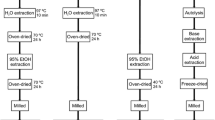Abstract
The role of dietary fibre on the water-holding capacity (WHC), as a functional property of starchy legumes, was investigated. The WHCs of butter beans, broad beans and lentils were found to be in the range 1.35–1.82 g water/g in the raw forms, and in the range 1.81–2.63 g water/g for the cooked forms, with a contribution of 35.9–56.1% by the equivalent fibre-rich fractions (FRFs). Non-starch polysaccharides (NSPs) were found to be in the range 14.1–18.1 and 27.1–38.1 g/ 100g for the three legumes and their FRFs, respectively. Arabinoxylans, which enhance the WHC, were found at levels of 8.6–11.6% concentration in the NSPs of the FRFs.
Similar content being viewed by others
References
AACC (1983) Approved Methods of the American Association of Cereal Chemists, 8th edn. St Paul, MN: American Association of Cereal Chemists
Camire AL, Clydesdale FM (1981) Effect of pH and heat treatment on the binding of Ca, Mg, Zn and Fe to wheat bran and fractions of dietary fibre. J Food Sci 46: 548–551
Chen JY, Piva M, Labuza TP (1984) Evaluation of water-binding capacity (WBC) of food fibre sources. J Food Sci 49: 59–63
Englyst HN, Wiggins HS, Cummings JH (1982) Determination of non-starch polysaccharides in plant foods by gas-liquid chromatography of constituent sugars as alditol acetates. Analyst 107: 307–318
Gray H, Tainter ML (1941) Colloid laxatives available for clinical use. Am J Dig Dis 8: 130–139
Holloway WD, Grieg RI (1984) Water-holding capacity of hemicelluloses from fruits, vegetables and wheat bran. J Food Sci 49: 1632–1633.
Jenkins DJ, Wolever TM, Taylor RH, Barker H, Fielden H, Badwin JM, Bowling AC, Newman HC, Jenkins AL, Golf DV (1981) Glycemic index of foods: A physiological basis for carbohydrate exchange. Am J Clin Nutr 34: 362–366
McConnell AA, Eastwood MA, Mitchell WD (1974) Physical characteristics of vegetable foodstuffs that could influence bowel function. J Sci Food Agri 25: 1457–1464
Mongeau R, Brassard R (1982) Insoluble dietary fibre from breakfast cereals and brans: Bile salt binding and water-holding capacity in relation to particle size. Cereal Chem 59: 413–417
Parrot ME, Thrall BE (1978) Functional properties of various fibres: Physical properties. J Food Sci 43: 759–763; 765
Robertson MA, Eastwood MA, Yeoman MM (1980) An investigation into the physical properties of fibre prepared from several carrot varieties at different stages of development. J Sci Food Agri 31 (7): 633–638
Robertson JA, Eastwood MA (1981a) An examination of factors which may affect the water-holding capacity of dietary fibre. Br J Nutr 45: 83–88
Robertson JA, Eastwood MA (1981b) An investigation of the experimental conditions which could affect water-holding capacity of dietary fibre. J Sci Food Agri 32: 819–825
Stephen AM, Cummings JH (1979) Water-holding capacity by dietary fibre in vitro and its relationship to faecal output in man. Gut 20: 722–729
Trowell HC (1975) Dietary fibre hypothesis of the etiology of diabetes mellitus. Diabetes 24: 762–765
Author information
Authors and Affiliations
Rights and permissions
About this article
Cite this article
Elhardallou, S.B., Walker, A.F. The water-holding capacity of three starchy legumes in the raw, cooked and fibre-rich fraction forms. Plant Food Hum Nutr 44, 171–179 (1993). https://doi.org/10.1007/BF01088382
Received:
Accepted:
Issue Date:
DOI: https://doi.org/10.1007/BF01088382




